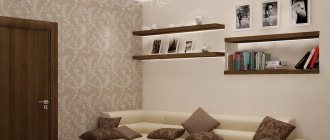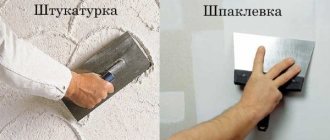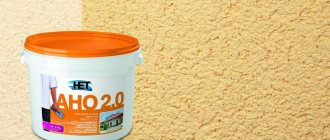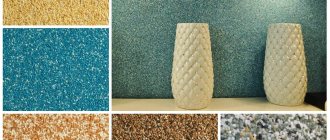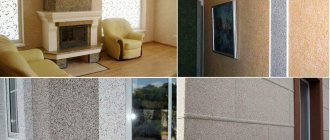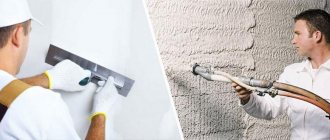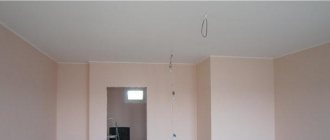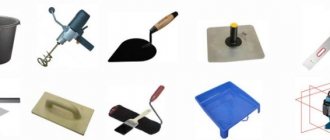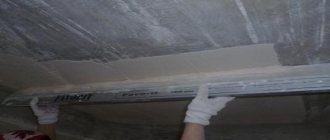Purchasing plaster for a facade can sometimes be quite difficult, since there is a wide variety of products.
There are cheaper options, but their quality is quite low. A good choice would be vapor-permeable plaster, which has recently gained great popularity among specialists in the construction trade.
There are more and more people wanting to make a vapor-permeable finish every day, but not many know what materials and tools will be needed for this. In this article we will take a closer look at the characteristics of vapor-permeable plaster and talk about its advantages.
What is vapor permeability
Vapor-permeable surfaces “breathe” and high humidity does not form in the room.
Vapor permeability is the ability of a coating to retain or transmit steam. If the surface has good vapor permeability, it is called breathable.
At the same time, due to the structure of the solution, it will be able to pass air and steam through it. This property is quite a significant advantage.
The fact is that steam is the result of human activity. It is formed during breathing, cooking, bathing and other things. In the absence of ventilation, high humidity forms in the room.
In turn, high humidity can cause a lot of trouble. Because of it, mold can form on the wall or a person may develop an allergy. But the high vapor permeability of the walls will allow you to avoid this. It will significantly improve the microclimate in the room, reduce humidity and prevent the appearance of mold or mildew.
Where is the product used?
Where is elastic plaster used?
Most often, plaster is used as a facade plaster - it is used for the final finishing of the outside of a building, structures and structures. After drying, a kind of dense, but still breathable membrane will form on the surface, which will not allow water to pass through, will protect the walls and will not develop cracks when the foundation shrinks and moves. Plaster has high tensile properties, and therefore it can be used even on very difficult areas of facades. The material is ideal for new buildings, as well as buildings located in seismically active zones. Elastic compositions are excellent for the final design of insulated buildings as part of plastering systems.
The elastic mixture is useful for wet rooms - toilets, bathrooms, basements, swimming pools, and baths. The plaster layer can both stretch and shrink, and therefore it can be used when cladding halls, corridors, and staircases. Plaster is usually used to cover stucco molding made of gypsum, products made of polyurethane, foam plastic, and also to finish the surface of walls with a large number of seams and joints to obtain a seamless coating. If necessary, floor coverings such as carpet or parquet are glued onto flexible plaster for interior work.
Varieties
The material is produced in two most popular versions:
- Acrylic elastic plaster. This mixture is required for final processing and protection of premises, facades, as well as other external and internal structures. It is made on the basis of acrylic resin, and is also intended for work on brick, concrete, stone, galvanized steel, slabs, other materials and plastic. The material is also resistant to frost temperatures and humidity levels.
- Elastic decorative plaster. In addition to protecting surfaces, the product will have another purpose - giving it a beautiful appearance. The decorating effect is achieved by including filler with different shapes and grain sizes, and also by using special techniques for processing the plaster layer.
Please note that most often decorative plasters contain polymer fibers, and a little less often stone chips of natural origin. Using such mixtures, it is possible to provide various effects to the surface: “fur coat”, imitation gypsum, “fleece”, “bark beetle” and everything else. Tinted decorative plasters are used using the sgraffito technique.
Features of finishing with vapor-permeable plaster
Vapor-permeable mixtures are applied from a foam concrete wall.
Finishing with such a solution has its own nuances that must be taken into account. Before you begin, you need to pay attention to the following factors:
- the level of comfort in any room depends on the vapor permeability of the walls;
- Their service life depends on the hygroscopicity of the materials used during processing.
Most often, vapor-permeable plaster is applied to surfaces made of foam and aerated concrete. Working with such coatings requires certain skills and experience. There are quite a lot of solutions with vapor-permeable characteristics. Against their background, one can distinguish a gypsum-based plaster mixture. It includes:
- perlite sand;
- gypsum;
- slaked lime.
This solution is distinguished by its low price. In addition, its use does not require special surface preparation. With this material you can easily ensure vapor permeability of the walls of any room.
Keep in mind that when painting vapor-permeable walls, it is better to use water-based products. Oil mixtures can significantly reduce vapor permeability.
General information
Description and history of the product
Elastic plaster is often also called rubber plaster. Naturally, the composition does not contain standard rubber ingredients, but the properties will indeed resemble such a plastic material that can bend without damaging the surface. Just like rubber, elastic plaster can elongate when stretched by 15% or more, and does not crack when the base is displaced, moved, or vibrates. Today, flexible plaster is included in the product range of many famous companies producing building mixtures. In terms of façade-type work, the material competes with simple mineral plasters, which even with slight shrinkage of the building begin to deteriorate. Due to their low elasticity and elasticity, mineral mixtures are not able to withstand difficult operating conditions and quickly cease to provide the required protection to structural elements.
The main component of flexible plaster mixtures is acrylic resin - a substance that was invented back in the 20th century. Like other resins of artificial origin, it is characterized by flexibility after hardening, and therefore they are widely used to create various building materials - paints, plasters and stone. At first, paints were made on the basis of acrylic, dyes and water, to which mineral fillers were then added (up to 70% of the total mass). The following can be used as a filler:
- Quartz sand.
- Synthetic and natural fibers.
- Stone chips.
Please note that in order to improve the characteristics of the composition, various additives for modification, as well as plasticizers, began to be introduced into it. Certain types of hardening plaster contain cement, which, when combined with acrylic, makes the coating very resistant to mechanical stress.
Pros and cons of plaster
The plaster is produced in finished form, and no mixing of ingredients is required. Once applied and dried, it forms a seamless, weather-resistant finish.
The advantages of an elastic mixture are:
They are produced in different shades, and also in white, and can be tinted in any colors, and can also be painted after drying.- It is easy to lay down, does not require special knowledge for plastering, and also dries quickly.
- It can serve as a decorative mixture, and, if necessary, is subjected to relief-type processing.
- Eco-friendly, does not emit harmful substances even when heated, and does not emit an unpleasant aroma.
- It has a high degree of adhesion to a large number of building materials (wood, concrete, bricks and other porous substrates), and does not lag behind wall surfaces.
- It can even be applied to a layer of insulation, for example, polystyrene foam, and also to other types of plaster.
- Universal, suitable for all types of work, finishing partitions and interior walls, cladding buildings and reconstructing old buildings.
- In addition, flexible plaster for facades is not afraid of exposure to water, sun, is not destroyed by ice expansion, and can also be used in rooms with high humidity.
- Permeable to gases and water vapor, but does not change the conditions of the optimal microclimate indoors.
- Withstands temperature changes from -50 to +65 degrees, and does not deteriorate from freezing and thawing.
- It is considered non-flammable, and it also creates structural fire safety.
- The color will not fade or fade over time.
- Prevents the formation of moss, mold and lichens.
- It can last up to several decades without loss of operational characteristics.
- It can be easily removed from dirt and dust and can be washed with plain water.
There are very few disadvantages to this product. This material cannot be called inexpensive - its cost is quite high, and complete finishing for a building can cost a pretty penny. Moreover, it is not suitable for rough leveling in a thick layer, but is required only for decorative and finishing purposes. Elastic plaster does not like joints or seams, and therefore it is advisable to cover each surface in one approach.
Specifications
“Rubber” plaster may have different technical characteristics, which will vary depending on the manufacturer. The average parameters of materials of this type are:
- Consumption ranges from 0.5 to 2.8 kg per square meter (depending on the type and evenness of the base).
- The drying time before treatment begins is from 12 to 24 hours.
- Time to gain ideal strength is from 2 to 4 weeks
- The water absorption rate is less than 1%.
- The proportion of solids is up to 70%.
- Coloring is available in different RAL colors.
- Can be diluted with water up to 2%.
Materials for vapor-permeable wall treatment
Gypsum in plasters improves vapor permeability.
To increase the vapor permeability of aerated concrete surfaces, plaster solutions and putty based on gypsum are used. Such materials are preferred by both professionals and beginners in the construction business.
They contain sand and slaked lime. The mixtures do not require priming, and water vapor easily passes through their finishing layer.
For such processing, ready-made solutions are often used. They include the following additives:
- chalk;
- lime;
- dolomite;
- marble.
There are the following types of vapor-permeable plasters:
- Mineral. They are quite popular among specialists. They are characterized by low cost, since they contain cement and sand. It has a high level of vapor permeability and low water absorption. The treated surface will have a long service life and dust will not settle on it. Keep in mind that such plaster requires additional finishing, as it has a rather dull color scheme.
- Silicate. The mixture received this name due to the presence of liquid glass in its composition. The solution has a high level of vapor permeability and goes well with mineral slabs. In addition, the cladding is impervious to mold or mildew, and the treated surface prevents dust from settling. The downside is a slight change in shade on the walls when wet, but after drying everything returns to normal.
- Silicone. The plaster consists of silicone resins, which have good adhesion and high vapor permeability. In addition, the treated coating is not susceptible to moisture. The cost of such solutions is quite high. But in return you will get a wide variety of color shades and textures. For more information about the vapor permeability of materials, watch this video:
Keep in mind that when purchasing a solution, special attention should be paid to the size of its grains.
Some manufacturers produce compounds that can be grouted and have a good whiteness rating.
Although such mixtures contain a large number of polymers, their vapor permeability is much higher than that of conventional plaster.
After processing, you will receive a durable coating and can easily proceed to further processing.
Keep in mind that aerated concrete does not need putty, but it does need priming. Failure to prime may result in further cracking and crumbling of the surface.
Kinds
Vapor-permeable plaster for external use comes in several types:
- based on mineral components. This material is prepared from sand and cement, to which special additives are added so that the plaster material ultimately meets the requirements for materials applied to aerated concrete walls. The solution is durable and, due to the main raw materials, is quite cheap;
- on a silicate basis. The main component of such a material is considered to be liquid potassium glass, due to which the plaster composition has a high vapor permeability rate, excellent resistance to mold formation, and has good hydrophobic properties;
- silicone based. This plaster mixture is highly expensive, but is considered the best material among those on the market today. Its production is based on silicone resins, which have excellent vapor permeability, a high level of adhesion, and numerous decorative solutions.
Tools for work
When working with aerated concrete surfaces, it is necessary to use the same tools as for conventional cladding.
Breathable plaster is laid using a trowel or ladle; for large areas you can use a trowel. Grouting is done using a grater.
The quality of work is checked after applying the plaster with a long straight strip.
To remove the remaining mortar from the wall, we recommend using a polisher, and to level uneven areas of the surface you will need to first install beacons.
After completing the procedures, we recommend making sure that all work was carried out correctly. For these purposes, a long strip is used; it is applied to the wall vertically and horizontally. If the processing is uneven, you will immediately notice defects.
The range of permissible unevenness is about 7 mm.
Plaster for aerated concrete
To prevent cracks from appearing on aerated concrete, it must be protected from carbonization shrinkage, moisture and air penetration. Plaster works well as protection. It can either fix or completely ruin the walls. For aerated concrete walls, one of the significant characteristics is the vapor permeability of the plaster, its thickness and the ratio of the thickness of the inner and outer layer. It is necessary that the steam entering the wall through the plaster inside the room exits without obstacles to the outside. In this embodiment, the walls are able to “breathe”, but if steam does not escape or settles from inside the walls, then after some time, due to temperature fluctuations and due to the fact that the moisture either freezes or melts, cracks appear, the plaster on the outside falls off, and Mold forms on the inside. If there are no calculations, then you can use the experience of the master and do the plaster in such a way that the outside layer is twice thinner than the inside. For example, if the outside plaster is 1 cm thick, then the inside should be 2 cm thick. Vapor-permeable plaster for aerated concrete should not have a thick layer, a maximum of 2 cm inside the building. The plastered wall is painted only with facade paints, which are also vapor permeable.


